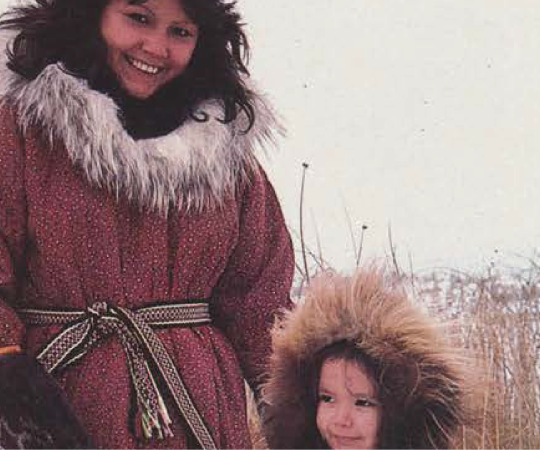It was the coldest of cold cases. Lucy Johnson, a 25 year-old married mother of two, had last been seen by a neighbour in Surrey, B.C., in September 1961. Fifty-one years and 10 months later, in late June 2013, the Missing Persons Unit at the Surrey detachment of the RCMP decided to knock the dust off her file.
Constable Mike Halskov, the officer who was assigned to the case, wasn’t optimistic: “Generally speaking, missing person files of that vintage, if they’re solved ever, are solved with the discovery of someone’s remains.” The Mounties had no new information to work with, no leads or tips. There was nothing left to do, recalls Halskov, but to take the story to the media and hope for the best.
So the Surrey detachment featured Johnson in their “Missing of the Month” series, issuing a media release with Johnson’s sepia-toned photograph and a thumbnail description of her case. “At the time of her disappearance Lucy was 5’5 tall, 110 lbs, with a dark complexion, dark brown hair, medium build, and of First Nations descent,” the release stated. “She would now be 77 years old.”
Three weeks later, Johnson was found. She had been living in the Yukon, under a new name, all along. The story went viral. The Globe and Mail, the National Post, CBC, Global – every major Canadian news outlet ran with it. Even the notorious New York City gossip page, Gawker.com, picked it up. Speculated one commenter on the site: “So, her husband was so awful she decided a life in the cold, unforgiving Yukon was better than life with him? Ouch.” Another took the opposite view: “Nothing says ‘I love you’ like total abandonment.”
It was the kind of bizarre, unexpected story that seems designed to light up the internet. But at the same time, it sort of made sense. Was the outcome really so surprising? After all, the North has always been a place where people go to disappear.

ONE YEAR BEFORE the Johnson case returned to the news, another disappearance hit the papers. In late June 2012, the Whitehorse detachment of the RCMP announced that a 24 year-old German man, Till Moritz Gerull, had been missing in the Yukon for almost exactly a year. Gerull had arrived on the weekly Condor Airlines flight from Frankfurt, Germany, on June 8, 2011. He had planned, said the Mounties, “on walking through the forests of Canada.” He never boarded his return flight, and no trace of him was ever found.
Gerull, from what little is known of him, fits neatly into one common category of Northern disappearing act: the wilderness seeker, the type who reads Thoreau and John Muir and Jack London and decides to immerse himself in the vastness of the Northern backcountry.
The most well-known of the wilderness seekers was Christopher McCandless, the young suburbanite-turned-drifter made famous in Jon Krakauer’s book, Into the Wild, and the Hollywood movie of the same name. McCandless disappeared from Atlanta just after his college graduation, assumed the named Alexander Supertramp, and thumbed his way around the western United States for two years before heading north to Alaska. There, in late April, 1992, he made his home in an abandoned bus just outside the boundaries of Denali National Park, intending to live entirely off the land. He carved a sort of manifesto into an old plywood sheet he found there:
“Two years he walks the earth. No phone, no pool, no pets, no cigarettes. Ultimate freedom. An extremist. An aesthetic voyager whose home is the road … Ten days and nights of freight trains and hitchhiking bring him to the great white north, no longer to be poisoned by civilization he flees, and walks alone upon the land to become lost in the wild.”
McCandless’ body was found by a group of moose hunters in September; he had starved to death.
The wilderness seekers come North looking for something, but another breed of disappearing acts arrives hoping to hide – from the law, or from a murky past.
In early 1932, Albert Johnson, better known as the “Mad Trapper of Rat River,” the Canadian North’s most famous fugitive, led the Mounties on an epic month-long manhunt that ended with his death in a shootout. The case had begun innocuously enough, with the police visiting Johnson’s cabin to inquire about some tampering with a neighboring trapper’s line. Johnson ignored them, and when they returned with a warrant, he shot one of them through the door, and the chase was on. His background and identity were never fully verified, but given his response to the Mounties it seemed safe to assume this wasn’t his first run-in with the law.
During his brief time in the North, Johnson had never seemed like the neighborly type. But not all Northern fugitives keep to themselves. In 2000, Yellowknifers were shocked to learn that a friendly Old Town bed-and-breakfast owner, a community fixture, had a dark, violent past. Lothar Ebke, who’d arrived in Canada and headed North in the mid-90s, was a wanted terrorist back in his native Germany. He was believed to be a former member of the Revolutionary Cells, a group known for airline hijackings and numerous bombings. He was wanted for at least one bombing and was also a suspect in two high-profile shootings, including one of a federal judge. The charges seemed impossible to believe. According to the CBC, when his case reached the Supreme Court of Canada in 2003 for his final appeal against extradition to Germany, handfuls of Yellowknifers submitted letters in support, “describing Mr. Ebke as a kind and helpful man with a strong sense of community and love for the North.”

He lost his appeal. Ebke would later admit in German court to planning one bombing and executing another.
In the early 1980s, another fugitive, the “world’s top techno bandit” came North fleeing justice. Charles McVey was a wanted man in California, accused of “masterminding plots to pass computer and satellite secrets to the Soviet Union,” according to the Los Angeles Times. The technology he was suspected of shipping to the enemy was worth millions. McVey had vanished from the U.S. in 1983, after the indictments came down, and stayed on the run for four years without being found. But in 1987, rumours reached the Mounties that he might be in the Yukon. In August, McVey was spotted at a restaurant in Teslin by an RCMP corporal who’d only been in town for three weeks. The next day the officer, Cpl. Daniel Fudge, armed with backup and a warrant, tracked McVey to a private residence in Teslin and arrested him. While on the lam, the wealthy fugitive had, apparently, been spending his time fishing.
Not all the fugitives who run North are high-rollers like McVey. Some work regular jobs and live regular lives among us, their pasts safely hidden. For many years, a man who called himself David Donald McFee lived and worked in the NWT, making a living as a long-haul trucker. He married, had kids, and watched them grow. But the man’s real name was William Walter Asher III, and he had escaped from a California prison camp in 1975. Asher had been imprisoned for his part in an armed robbery in San Francisco that ended in the violent beating and shooting death of a bartender. After decades of hiding out in the North, he headed back to his home in California. He was arrested in Salida in 2011, after 36 years on the run.
One notorious case combined the wilderness seeker and the fugitive in one strange, unforgettable man. In official court records, he was called Robert Hale, and in decades past he had gone by the name Firefly Sunstar. But most people know him as Papa Pilgrim.
Pilgrim came from a powerful Texas family; his father had been a prominent FBI agent, and as a teen he had eloped with a young woman whose father went on to become governor. His turbulent early years included the suspicious shooting death of his teenage first wife, bizarre ties to Lee Harvey Oswald and the Kennedy assassination, an encounter with Charles Manson, and a stint as a tenant on a New Mexico plot of land owned by Hollywood star Jack Nicholson. It was inevitable that he would wind up in Alaska.
In the early 2000s, Pilgrim and his wife, Mama Country Rose, convoyed up the Alaska Highway with their 14 children. They passed through the Yukon and spent a couple of years drifting around Alaska. Eventually they settled in McCarthy, a ghost town in the heart of Wrangell-St. Elias National Park. Pilgrim hoped to build a homestead in the vast Wrangell backcountry, away from the meddling neighbors and law-enforcement officials he’d tangled with in the past. But when he bulldozed a road across 13 miles of national park land, he ignited a legal battle that led to media scrutiny, the dusting-off of his secrets, and, eventually, the escape of several of his elder children, who went to the police with stories of serial physical and sexual abuse. Pilgrim’s homestead, “Hillbilly Heaven,” was abandoned, and the man himself died in jail.

AFTER LUCY JOHNSON was found, a few details began to trickle out about her case. While she had been listed as a missing person since 1965, it appeared that she had never thought of herself as such. She had left her husband, Marvin Johnson, in September 1961, for reasons that remain unclear. He, in turn, had waited four years to report her missing – a gap that left him under a cloud of suspicion throughout the decades, until his death in the 1990s. But as Constable Halskov explains, in Johnson’s mind his wife had simply left him; she wasn’t missing, she was just gone. It wasn’t until he had met someone else and wanted to remarry that Marvin Johnson went looking for his estranged wife. Unable to locate her, he turned to the police.
In the meantime, Lucy Johnson had moved north, to the Yukon, and met a man and remarried too – a crucial detail, since it meant that she’d changed her name. When the Surrey detachment began its search for Lucy Johnson, technically speaking, she no longer existed. In the 1960s, says Halskov, there were no centralized databases, no ready means for the police to look into the records in far-flung jurisdictions. The Mounties who investigated the Johnson case in 1965 conducted a full investigation using the tools at their disposal at the time, but they had no way of tracking a woman who’d started fresh with a new name. It wasn’t like today, Halskov says, “where these stories can travel around the world in a matter of seconds … It was a different era then.”
Lucy Johnson was born in Skagway, Alaska, in 1935. She bounced around Alaska and the southern Yukon throughout her childhood, before heading south from Carcross, Yukon, at the age of 18. So when she came back North in the early 1960s, she wasn’t a southerner in search of wilderness or solitude; she was a Northerner coming home. Still, there were elements of a disappearing act to her return. She didn’t contact her family, still in the Yukon, when she came back – or if she did, she convinced them to hide her presence from the police: The Surrey detachment contacted all her known Yukon relatives when they investigated her disappearance in 1965, and all of them said they hadn’t heard from her.
Mystery still clings to her decision to go into hiding. A daughter from her second marriage, Rhonda, told the Whitehorse Star that she hadn’t asked her mother for her reasons. “I don’t think it’s any of my business,” she said.
Rhonda is the reason for Lucy Johnson’s reappearance. When the Missing Persons Unit featured Johnson as a Missing of the Month, her daughter from the marriage to Marvin, Linda Evans, decided to get involved. On a hunch, based on her mother’s childhood in the North, Evans “decided to take out some free advertising up in the Whitehorse area,” says Constable Halskov. Then, in Whitehorse, Evans’ unknown half-sister, Rhonda, spotted the ad, looked up the RCMP’s news release, and recognized her mother in the photo that went with it. “I was like, ‘what is Mom doing there? She’s not missing,’” she told the Star.
Soon, down in Surrey, Halskov’s phone was ringing. He saw that a call was coming in from an 867 number, recognized the area code from his own time in the North, and thought: What if? Minutes later, a 51-year-old cold case had been solved.

THESE DAYS, of course, it’s a lot harder to hide from your past, or to opt out of society, than it was in 1961. But in the North, even with broadband wireless and 4G cell service spreading inexorably from community to community, it’s still easier to pull off than most anywhere else. And it’s not just a phenomenon for wilderness-seeking extremists or criminals on the run. We joke about the oddballs among us – Yukoners even celebrate their “colourful five per cent.” But the truth is, plenty of Northerners are here because nowhere else quite seems to suit them. It’s been that way since Robert Service wrote his famous poem, “The men who don’t fit in” – even since a thousand years ago, when Eric the Red, banished from Europe for “some killings,” became the first white man in Greenland.
Lucy Johnson is reunited with her family. Chris McCandless and Papa Pilgrim are long gone, and the most anyone is likely to ever find of Till Moritz Gerull is the remnants of his body. But somewhere, lurking in Iqaluit or Inuvik or Dawson, or still daydreaming about escaping to the frontier, the next disappearing act is in the works.










